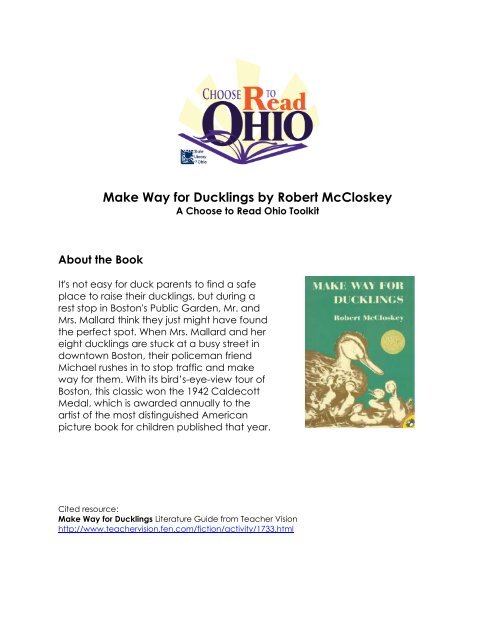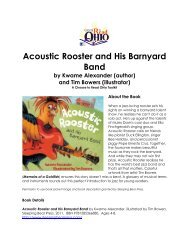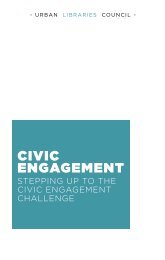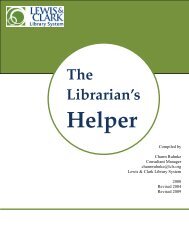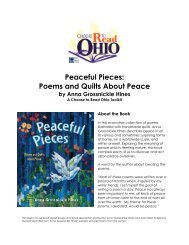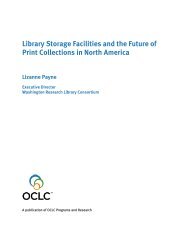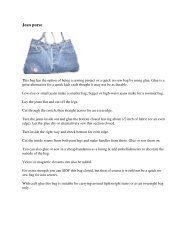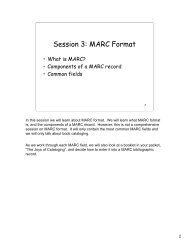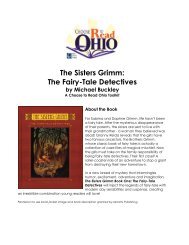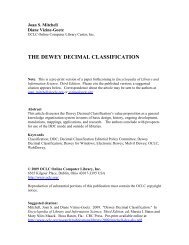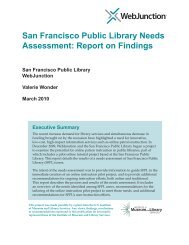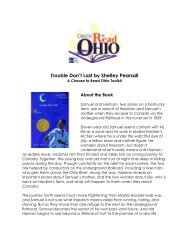Make Way for Ducklings by Robert McCloskey - WebJunction
Make Way for Ducklings by Robert McCloskey - WebJunction
Make Way for Ducklings by Robert McCloskey - WebJunction
Create successful ePaper yourself
Turn your PDF publications into a flip-book with our unique Google optimized e-Paper software.
<strong>Make</strong> <strong>Way</strong> <strong>for</strong> <strong>Ducklings</strong> <strong>by</strong> <strong>Robert</strong> <strong>McCloskey</strong>A Choose to Read Ohio ToolkitAbout the BookIt's not easy <strong>for</strong> duck parents to find a safeplace to raise their ducklings, but during arest stop in Boston's Public Garden, Mr. andMrs. Mallard think they just might have foundthe perfect spot. When Mrs. Mallard and hereight ducklings are stuck at a busy street indowntown Boston, their policeman friendMichael rushes in to stop traffic and makeway <strong>for</strong> them. With its bird’s-eye-view tour ofBoston, this classic won the 1942 CaldecottMedal, which is awarded annually to theartist of the most distinguished Americanpicture book <strong>for</strong> children published that year.Cited resource:<strong>Make</strong> <strong>Way</strong> <strong>for</strong> <strong>Ducklings</strong> Literature Guide from Teacher Visionhttp://www.teachervision.fen.com/fiction/activity/1733.html
About the AuthorBorn in Hamilton, Ohio in 1914, <strong>Robert</strong> <strong>McCloskey</strong>was encouraged <strong>by</strong> his parents to explore hisinterests. “I took piano lessons from the time myfingers were long enough to play the scale,” hewas once quoted. <strong>McCloskey</strong> also played theharmonica, drums and oboe. He tinkered withthe mechanics of old electric motors, clocks, andeven built trains and cranes with remote control.“The inventor’s life was the life <strong>for</strong> me, that is, untilI started making drawings <strong>for</strong> the school paper,”he said in an early interview. The Hamilton HighSchool graduate won a scholarship to the VesperGeorge Art School in Boston, which closed in 1984.In Boston, <strong>McCloskey</strong> often fed the ducks while walking through the city’s PublicGardens on the way to art school, but the young idealist’s mind was full of Greekmythology, Oriental dragons and the classic building blocks of art education.<strong>McCloskey</strong>’s urban encounters with mallard ducks, much like other early experiences,would come to life again when he became a children’s book author.His second and perhaps best-known book, <strong>Make</strong> <strong>Way</strong> <strong>for</strong> <strong>Ducklings</strong>, won the prestigiousCaldecott Medal in 1942. In the story, a mother duck searches the streets of Boston <strong>for</strong> asafe place to raise her young. <strong>McCloskey</strong> began the book <strong>by</strong> recalling the hilariousscenes of ducks crossing grid-locked Boston streets. To illustrate the detailed movementsof his characters with authenticity, <strong>McCloskey</strong> bought a half dozen southern mallards ata city market from a poultry dealer. He spent the next few weeks crawling around hisstudio, sketching the ducks and cleaning up their droppings. <strong>McCloskey</strong> put them in abathtub to sketch their swimming movements. And when they waddled too fast <strong>for</strong> himto draw, <strong>McCloskey</strong> fed the ducks red wine to slow them down. Evident from the richlydetailed charcoal illustrations, <strong>McCloskey</strong> returned to Boson to sketch the book’sbackground alive with parks, bridges, fences, streets, people, and cars.Other books written and illustrated <strong>by</strong> <strong>McCloskey</strong> include Lentil, Homer Price,Blueberries <strong>for</strong> Sal, Centerburg Tales, One Morning in Maine, Time of Wonder, and BurtDow: Deep Water Man. <strong>McCloskey</strong> died in 2003.Author Resources:Obituary and Tribute from The Horn Book magazinehttp://www.hbook.com/resources/obituaries/mccloskey.aspOhioana Authors: <strong>Robert</strong> <strong>McCloskey</strong>http://www.ohioana-authors.org/mccloskey/index.phpPhotograph Used with Permission from Penguin Young Readers. Text excerpted from “Ohioana Authors:<strong>Robert</strong> <strong>McCloskey</strong>”.
Discussion QuestionsBe<strong>for</strong>e ReadingHave a discussion about crossing the street safely. What should you do be<strong>for</strong>ecrossing the street? Discussion points might include looking both ways, holdingan adult’s hand, always crossing at an intersection, waiting <strong>for</strong> the “walk” light orthe crossing guard to signal it is safe to cross, etc.What do you find in a park? In a city? Ask whether a city would be expected tobe a good place <strong>for</strong> ducks to live.After Reading1. Why did the ducks want to cross the street? Have you ever needed tocross a busy street? What did you do?2. What do you think the ducks will do in the park?3. What do you like to do when you go to the park?4. What means of transportation do the ducks use? What means oftransportation do you see people using?5. How do you know the story took place many years ago?6. Name the physical features Mr. and Mrs. Mallard saw as they looked <strong>for</strong> aplace to raise their ducklings.7. Name the occupations you see pictured in the story.8. Discuss the man-made and natural elements of the setting. Whichcharacteristics of a park make it like a city? Which characteristics make itlike a natural area?
Extension ProjectsArts & CraftsEgg-Carton <strong>Ducklings</strong>: You will need a two-cup section from an egg carton(with the sections still attached), glue, construction paper, scissors, feathers,beads, and/or other decorations. Bend the egg carton cups towards eachother, rim to rim (making an oval shape). Glue the cups together to <strong>for</strong>m theduck's body. Cut out a bill and feet from the construction paper. Glue the feetand bill to the duckling's body. Add feathers, beads <strong>for</strong> eyes, or otherdecorations to complete your duckling.Language ArtsThe <strong>Ducklings</strong>' Names: The ducklings are named in alphabetical order -- Jack,Kack, Lack, Mack, Nack, Ouack, Pack, and Quack. Write each duckling's nameon a file card, then scramble the order of the file cards, and help kids practiceputting them back in alphabetical order. Think of new names <strong>for</strong> the ducklingsthat mirror the same alphabetical sequence.Library skillsUse the library catalog to identify books and other resources about mallardducks and ducklings. Locate pictures of and facts about mallard ducks.GeographyDraw a Map: Draw pictures of objects and characters from the story, then placethem on a map of Boston. You may want to make a large-scale, simplified mapof just the streets that are mentioned in the story. Kids can practice retelling thestory and retracing the ducks' routes.Social StudiesCommunities: This story takes place in a city, and you can find urbancharacteristics throughout the book. <strong>Make</strong> a chart highlighting thecharacteristics of and differences between a city, a suburban area, and a ruralarea. Compare and contrast the buildings, open spaces, transportation,population sizes, etc.Cited resource:<strong>Make</strong> <strong>Way</strong> <strong>for</strong> <strong>Ducklings</strong> Literature Guide from Teacher Visionhttp://www.teachervision.fen.com/fiction/activity/1733.html
Additional Resources<strong>Make</strong> <strong>Way</strong> <strong>for</strong> <strong>Ducklings</strong> lesson planhttp://www.d11.org/doi/socialstudies/SSGrade1/<strong>Make</strong>%20<strong>Way</strong>%20<strong>for</strong>%20<strong>Ducklings</strong>.pdfProvided <strong>by</strong> Colorado Springs School District 11Grade Level: Primary (grade 1)<strong>Make</strong> <strong>Way</strong> <strong>for</strong> <strong>Ducklings</strong> <strong>by</strong> Nancy Schon, Sculptorhttp://www.schon.com/public/ducklings-boston.phpThis sculptor has created bronze statues of the ducklings and Mrs. Mallard <strong>for</strong> the BostonGarden.Grade Levels: Pre-K, Primary, Intermediate<strong>Make</strong> <strong>Way</strong> <strong>for</strong> <strong>Ducklings</strong> resources from Scholastichttp://bookwizard.scholastic.com/tbw/viewWorkDetail.do?workId=2709&The Scholastic Teachers site offers an art lesson, writing prompt, and other extensionactivities <strong>for</strong> the classroom.Grade Levels: Pre-K, PrimaryMallard Duck from National Geographichttp://animals.nationalgeographic.com/animals/birds/mallard-duck.htmlThe National Geographic Animals site includes facts about the mallard, a map of itsrange, and an audio clip of its call.Grade Levels: Primary, IntermediateBook details:<strong>Make</strong> <strong>Way</strong> <strong>for</strong> <strong>Ducklings</strong> <strong>by</strong> <strong>Robert</strong> <strong>McCloskey</strong>. The Viking Press, 1941, Ages 3-8. ISBN-13: 978-0670-45149-4.About Choose to Read OhioChoose to Read Ohio (CTRO) spotlights Ohio authors and promotes reading across Ohio. TheState Library of Ohio, in partnership with Ohioana Library Association, developed this initiative toencourage Ohioans of all ages to share literature <strong>by</strong> authors native to, residing in, or associatedwith Ohio. CTRO is adaptable <strong>for</strong> use in classrooms, libraries, bookstores, <strong>by</strong> book discussiongroups, families, and other community groups.Explore Choose to Read Ohio resources & toolkits: http://oh.webjunction.org/ohctrointro.


